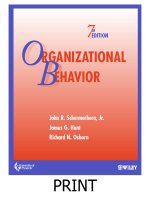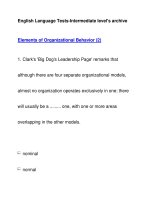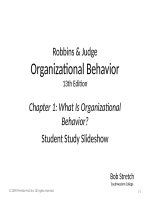SLide Organizational Behavior
Bạn đang xem bản rút gọn của tài liệu. Xem và tải ngay bản đầy đủ của tài liệu tại đây (2.4 MB, 141 trang )
Chapter 1
What is Organizational
Behavior?
This slide is adapted from
Robbins, S. P., & Judge, T. A. (2017).
Organizational Behavior (17th ed.).
England: Pearson Education.
5/30/22
HRM Division - DUE- UDN
1
Chapter Learning Objectives
After studying this chapter you should be able to:
Demonstrate the importance of interpersonal skills in
the workplace.
Define organizational behavior (OB).
Show the value to OB of systematic study.
Identify the challenges and opportunities managers
have in applying OB concepts.
Compare the three levels of analysis in this book’s OB
model.
5/30/22
HRM Division - DUE- UDN
2
Organizational Behavior
A field of study that investigates the impact that
individuals, groups, and structure have on
behavior within organizations, for the purpose
of applying such knowledge toward improving
an organization’s effectiveness.
5/30/22
HRM Division - DUE- UDN
3
The Importance of Interpersonal Skills
Understanding OB helps determine manager
effectiveness
Technical and quantitative skills are important
But leadership and communication skills are CRITICAL
Organizational benefits of skilled managers
Lower turnover of quality employees
Higher quality applications for recruitment
Better financial performance
Few Absolutes in OB
5/30/22
HRM Division - DUE- UDN
4
Luthan’s Study of Managerial Activities
Four types of managerial activity:
Traditional Management
• Decision making, planning, and controlling
Communication
• Exchanging routine information and processing paperwork
Human Resource Management
• Motivating, disciplining, managing conflict, staffing and
training
Networking
• Socializing, politicking, and interacting with others
5/30/22
HRM Division - DUE- UDN
5
Successful vs Effective Allocation by Time
Managers who promoted faster (were successful) did different
things than did effective managers (those who did their jobs well)
5/30/22
HRM Division - DUE- UDN
6
Intuition and Systematic Study
Intuition
Systematic
Study
• Gut feelings
• Individual observation
• Common sense
• Looks at relationships
• Scientific evidence
• Predicts behaviors
The two are complementary means of predicting behavior.
5/30/22
HRM Division - DUE- UDN
7
An outgrowth of Systematic Study
Evidence-Based Management (EBM)
Basing managerial decisions on the best available
scientific evidence
Must think like scientists:
Pose a
managerial
question
5/30/22
Search for
best
available
evidence
HRM Division - DUE- UDN
Apply
relevant
information
to case
8
Managers should use all three approaches
The trick is to know when to go with your gut.
– Jack Welsh
Intuition is often based on inaccurate information
Faddism is prevalent in management
Systematic study can be time consuming
Use evidence as much as possible to inform your intuition
and experience. That is the promise of OB.
5/30/22
HRM Division - DUE- UDN
9
Challenges and Opportunities for oB
5/30/22
Responding to Economic Pressures
Responding to Globalization
Managing Workforce Diversity
Improving Quality and Productivity
Improving Customer Service
Improving People Skills
Stimulating Innovation and Change
Coping with “Temporariness”
Working in Networked Organizations
Helping Employees Balance Work-Life Conflicts
Creating a Positive Work Environment
Improving Ethical Behavior
HRM Division - DUE- UDN
10
Responding to Economic Pressures
What do you do during difficult economic times?
Effective management is critical during hard economic
times.
Managers need to handle difficult activities such as
firing employees, motivating employees to do more
with less and working through the stress employees
feel when they are worrying about their future.
OB focuses on issues such as stress, decision making,
and coping during difficult times.
5/30/22
HRM Division - DUE- UDN
11
Responding to Globalization
Increased foreign assignments
Working with people from different cultures
Overseeing movement of jobs to countries
with low-cost labor
5/30/22
HRM Division - DUE- UDN
12
Managing workforce diversity
The people in organizations are becoming more heterogeneous
demographically
Embracing diversity
Changing U.S. demographics
Changing management philosophy
Recognizing and responding to differences
Disability
Domestic
Partners
Gender
Race
Age
Religion
5/30/22
National
Origin
HRM Division - DUE- UDN
13
Developing an OB Model
A model is an abstraction of reality – a simplified
representation of some real-world phenomenon.
Our OB model has three levels of analysis
Each level is constructed on the prior level
5/30/22
HRM Division - DUE- UDN
14
Types of Study Variables
Dependent (Y)
Independent (X)
The presumed cause of the
change in the dependent
variable (Y).
This is the variable that OB
researchers manipulate to
observe the changes in Y.
X
5/30/22
This is the response to X
(the independent variable).
It is what the OB researchers
want to predict or explain.
The interesting variable!
Y
Predictive Ability
HRM Division - DUE- UDN
15
Interesting OB Dependent Variables
Productivity
Transforming inputs to outputs at lowest cost. Includes the concepts of
effectiveness (achievement of goals) and efficiency (meeting goals at a
low cost).
Absenteeism
Failure to report to work – a huge cost to employers.
Turnover
Voluntary and involuntary permanent withdrawal from an organization.
Deviant Workplace Behavior
Voluntary behavior that violates significant organizational norms and
thereby threatens the well-being of the organization and/or any of its
members.
5/30/22
HRM Division - DUE- UDN
16
More interesting OB dependent variables
Organizational Citizenship Behavior (OCB)
Discretionary behavior that is not part of an
employee’s formal job requirements, but that
nevertheless promotes the effective functioning of
the organization.
Job Satisfaction
A general attitude (not a behavior) toward one’s
job; a positive feeling of one's job resulting from
an evaluation of its characteristics.
5/30/22
HRM Division - DUE- UDN
17
The Independent Variables
The independent variable (X) can be at any of these three
levels in this model:
Individual
Biographical characteristics, personality and emotions, values and
attitudes, ability, perception, motivation, individual learning, and
individual decision making
Group
Communication, group decision making, leadership and trust, group
structure, conflict, power and politics, and work teams
Organization System
Organizational culture, human resource policies and practices, and
organizational structure and design
5/30/22
HRM Division - DUE- UDN
18
OB MOdel
Three Levels
v
5/30/22
Dependent
Variables (Y)
Independent
Variables (X)
HRM Division - DUE- UDN
19
Summary and Managerial Implications
Managers need to develop their interpersonal skills to be
effective.
OB focuses on how to improve factors that make
organizations more effective.
The best predictions of behavior are made from a
combination of systematic study and intuition.
Situational variables moderate cause-and-effect
relationships, which is why OB theories are contingent.
There are many OB challenges and opportunities for
managers today.
The textbook is based on the contingent OB model.
5/30/22
HRM Division - DUE- UDN
20
BỘ MÔN QUẢN TRỊ NGUỒN NHÂN LỰC
THÁI ĐỘ VÀ
SỰ THOẢ MÃN
VỚI CÔNG VIỆC
CHƯƠNG 2
Năm học 2020-2021
Add
Believe
that your
you willcompany
succeed, andslogan
you will
NỘI DUNG CẦN NẮM VỮNG TRONG CHƯƠNG
Giới thiệu các thành phần của thái độ
Tóm tắt quan hệ giữa thái độ và hành vi
So sánh và giới thiệu những thái độ chính liên
quan đến công việc
Sự thoả mãn trong công việc và cách thức đo
lường nó
Tóm tắt những ngun nhân chính tạo nên sự thoả
mãn trong cơng việc
Trình bày bốn phản ứng với sự không thoả mãn
trong công việc
LOGO
LOGO
Add
Believe
that your
you willcompany
succeed, andslogan
you will
THÁI ĐỘ
Những phát biểu hay đánh giá
về sự vật, con người hoặc sự kiện
Ba
thành
phần
của
thái
độ
Nhận
thức
Thành phần về
quan điểm hoặc
niềm tin của thái
độ
Cảm
xúc
Thành phần cảm
xúc hoặc cảm
giác của thái độ
Hành vi
Thái độ
Ý định cư xử đối với ai
hoặc việc gì theo một
cách nhất định
LOGO
LOGO
Add your company slogan
CĨ PHẢI HÀNH VI LN PHÁT SINH TỪ THÁI ĐỘ?
CĨ PHẢI HÀNH VI LN PHÁT SINH TỪ THÁI ĐỘ?
Leon Festinger – Không, ngược lại thái độ theo sau hành vi
Sự không thống nhất về nhận thức: Bất kỳ sự khơng tương thích nào mà
một cá nhân có thể nhận thấy giữa hai hay nhiều thái độ hoặc giữa hành vi
và thái độ với nhau.
-
-
Cá nhân sẽ tìm cách giảm khoảng
cách khơng thoải mái, hay thiếu
tương đồng về nhận thức, để đạt
được sự ổn định và nhất quán
Tính nhất quán đạt được bằng cách:
thay đổi thái độ
điều chỉnh hành vi
hợp lý hoá
Mong muốn giảm sự thiếu tương đồng về
nhận thức phụ thuộc vào:
• Tầm quan trọng của các yếu tố tạo ra
sự thiếu tương đồng về nhận thức
• Mức độ cá nhân ảnh hưởng đến các
yếu tố này
• Phần thưởng đi kèm với sự thiếu tương
LOGO
LOGO
đồng về nhận thức
NHỮNG BIẾN SỐ ĐIỀU TIẾT
Kinh nghiệm cá
nhân trực tiếp về
thái độ
Áp lực của xã
hội lên cá nhân
Thái độ
Tầm quan
trọng của
thái độ
Các biến điều
tiết quan trọng
nhất của quan
hệ thái độ hành vi
Dự báo
Add
Believe
that your
you willcompany
succeed, andslogan
you will
Tính tương
hợp với hành
vi
Tính tiếp cận
của thái độ
Hành vi
Các biến số điều tiết
LOGO
LOGO









